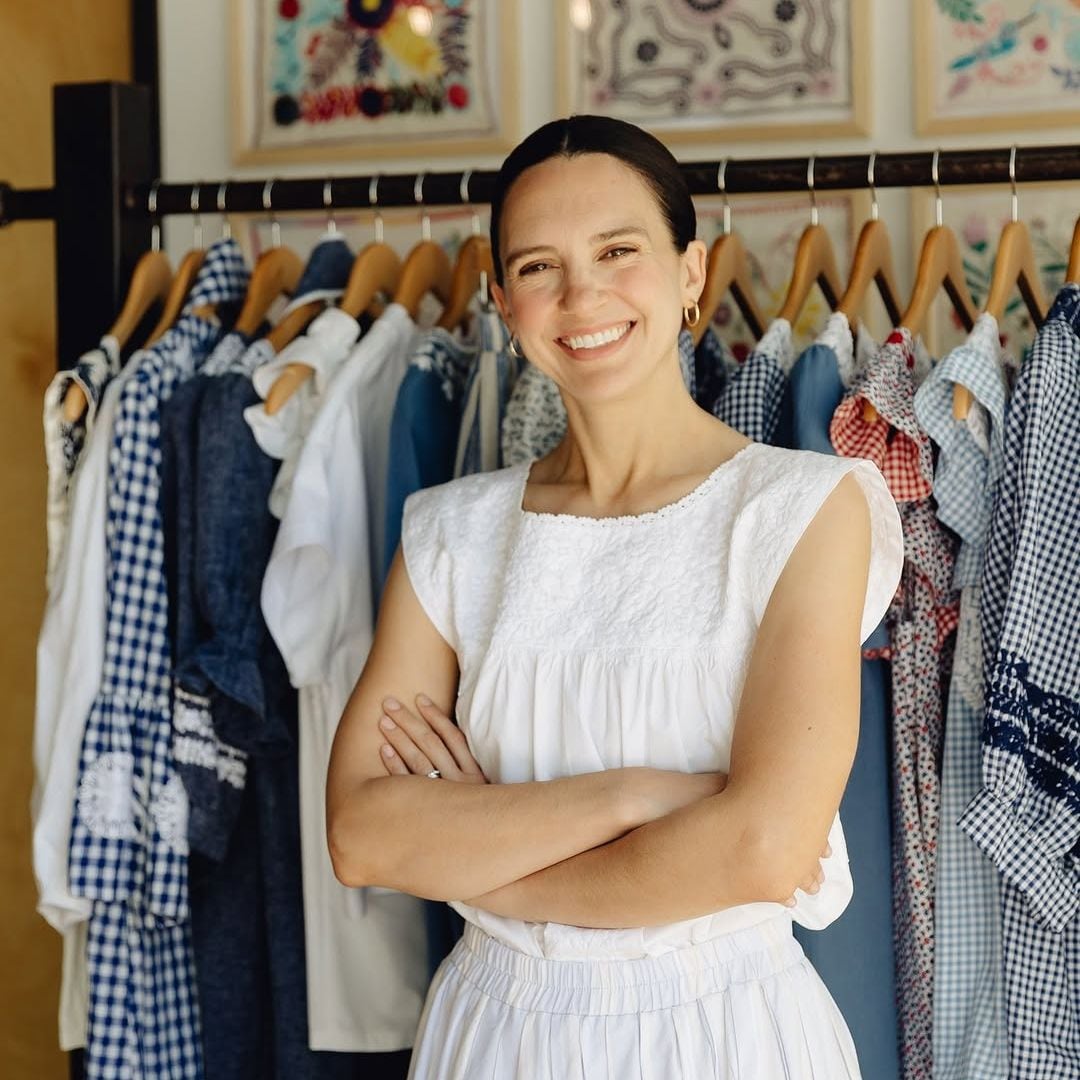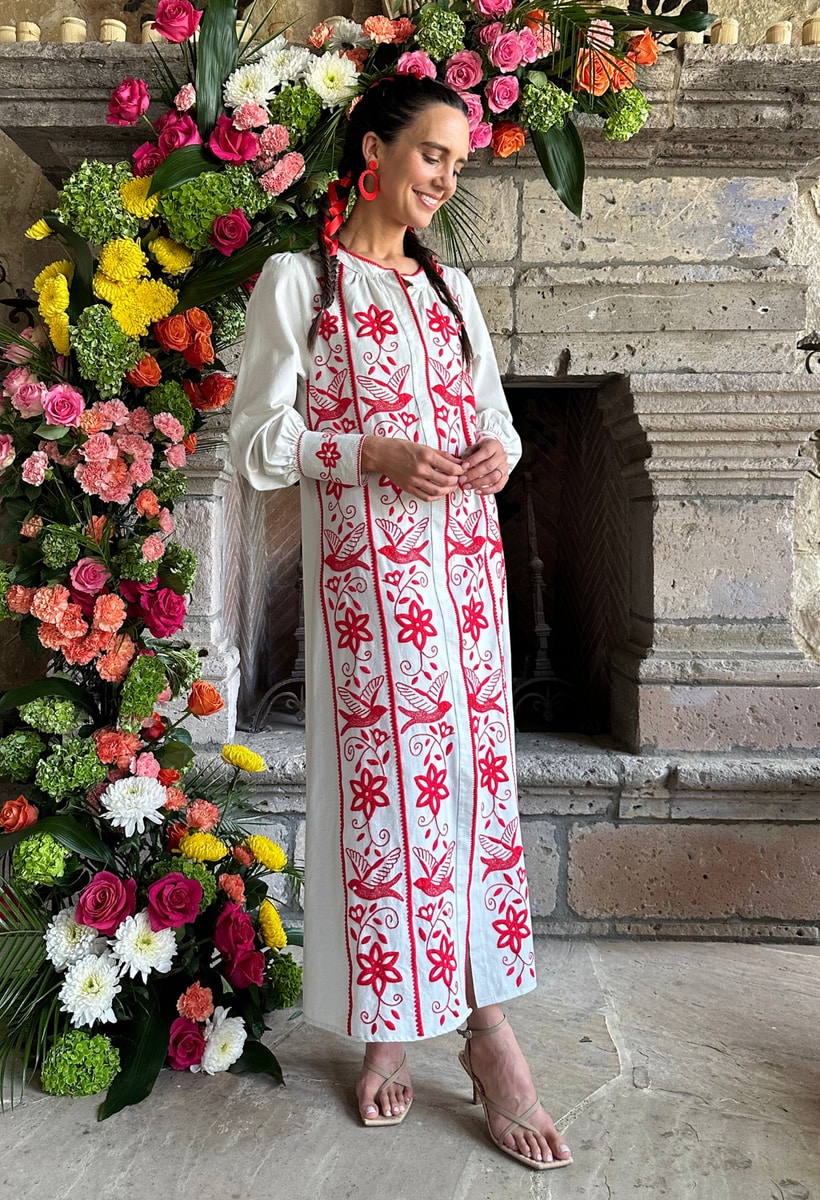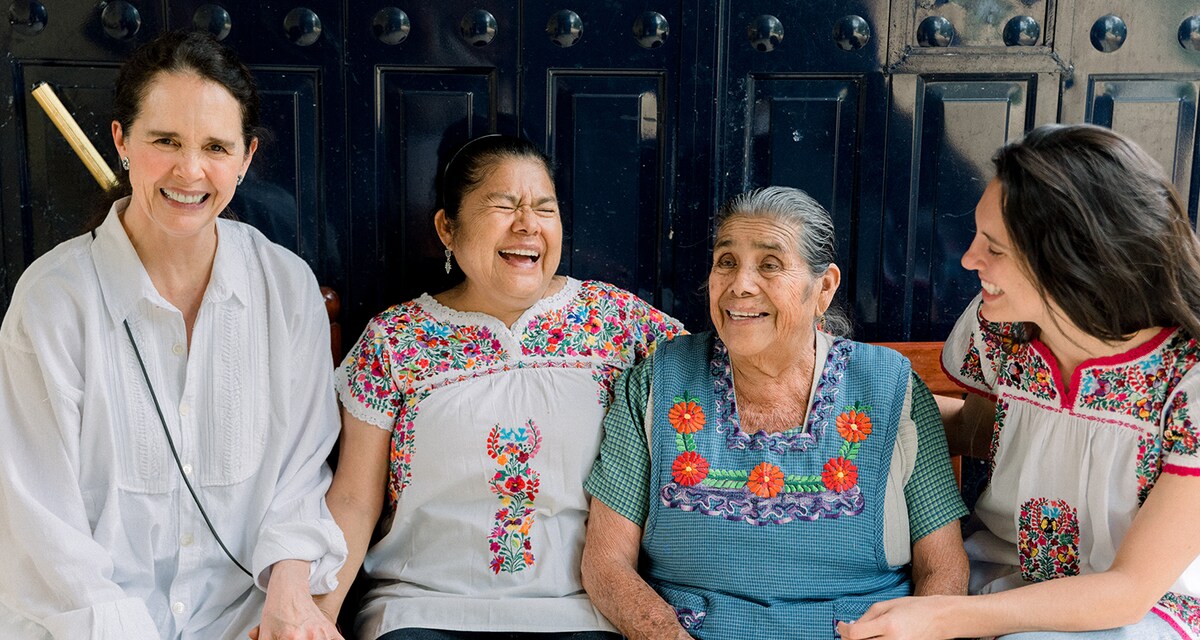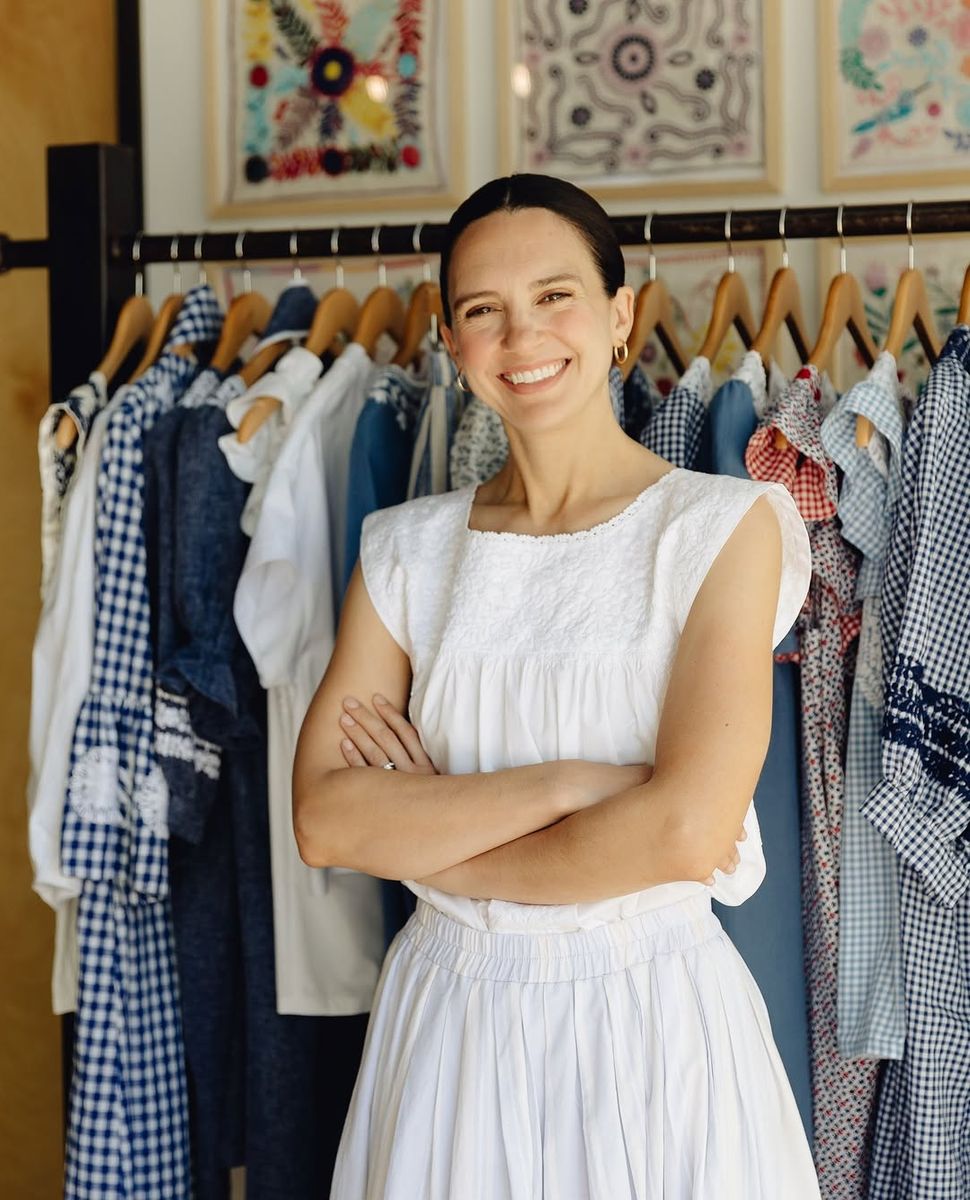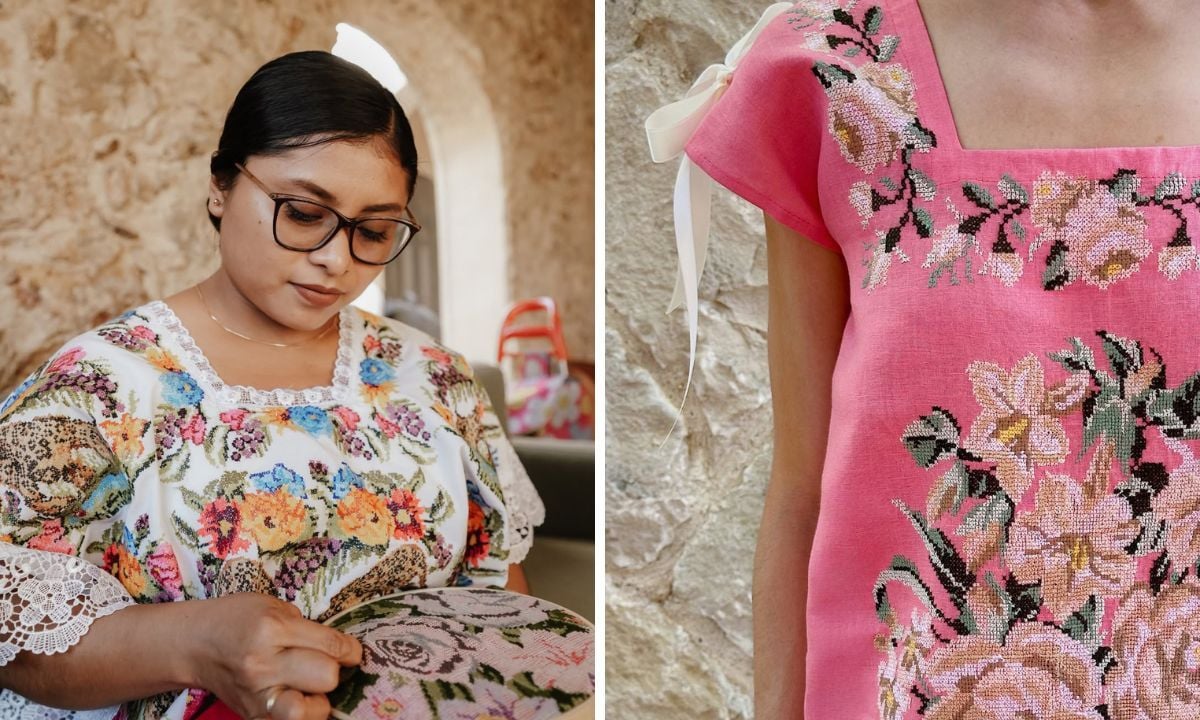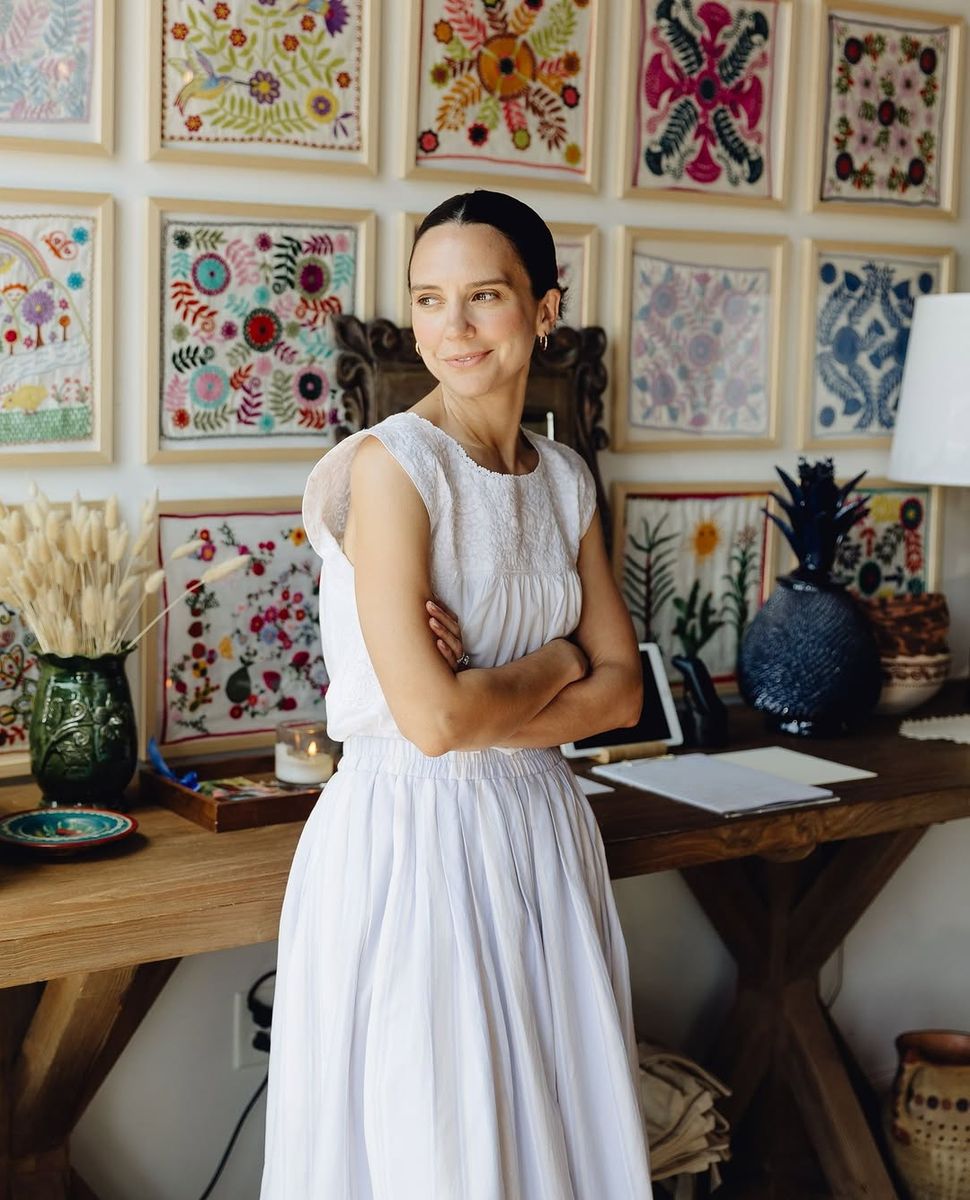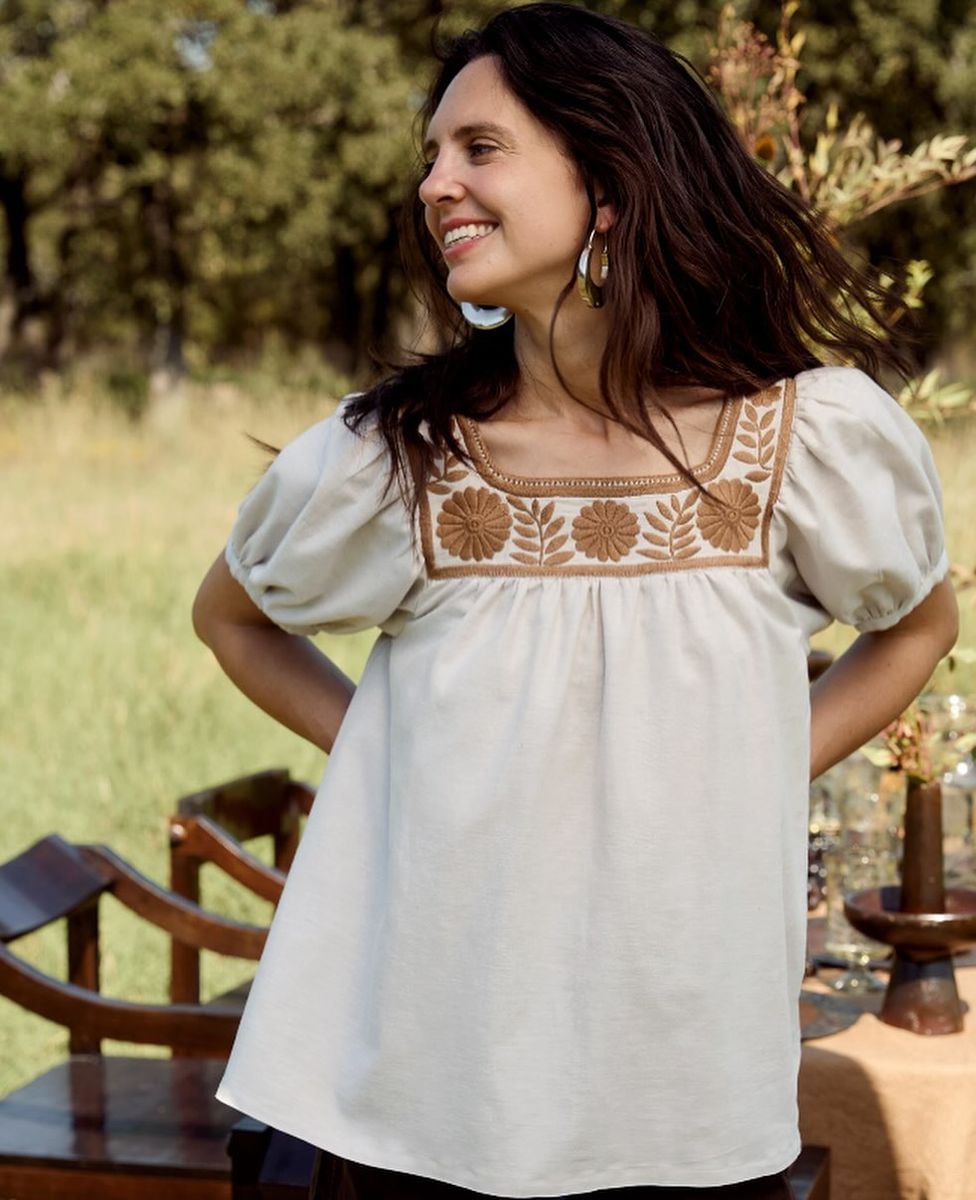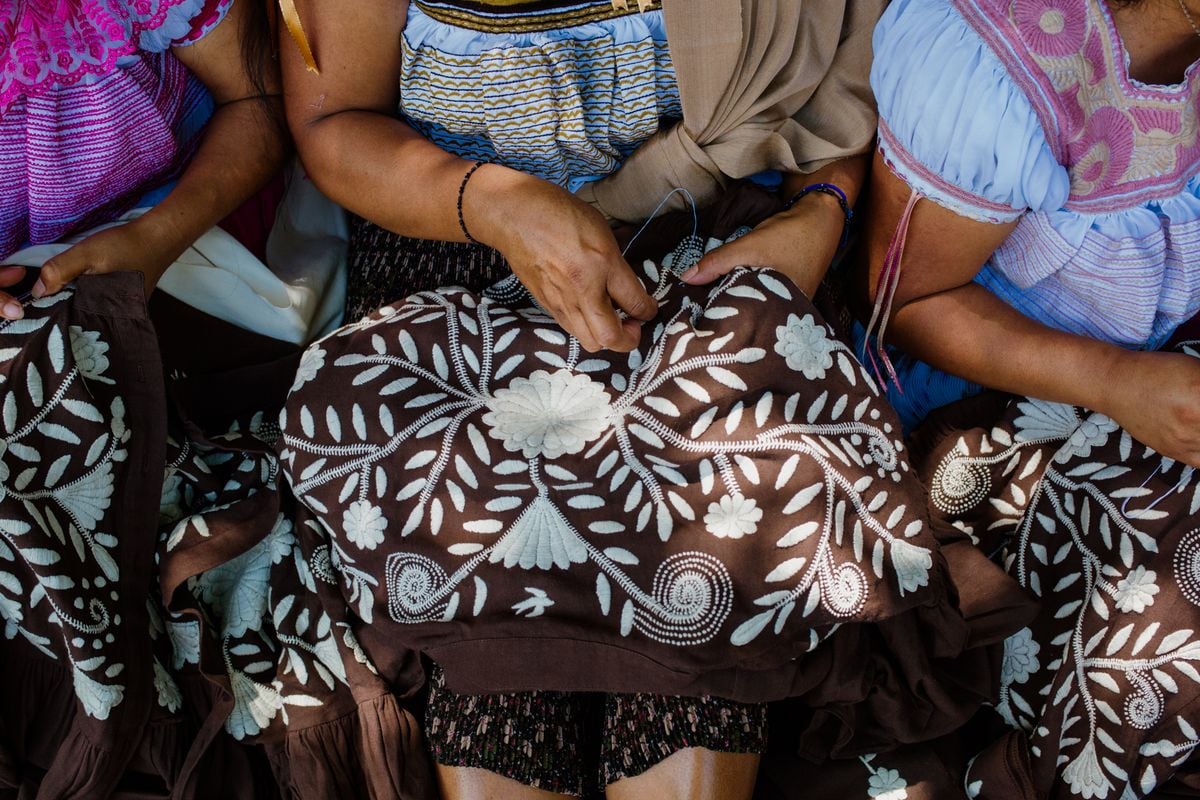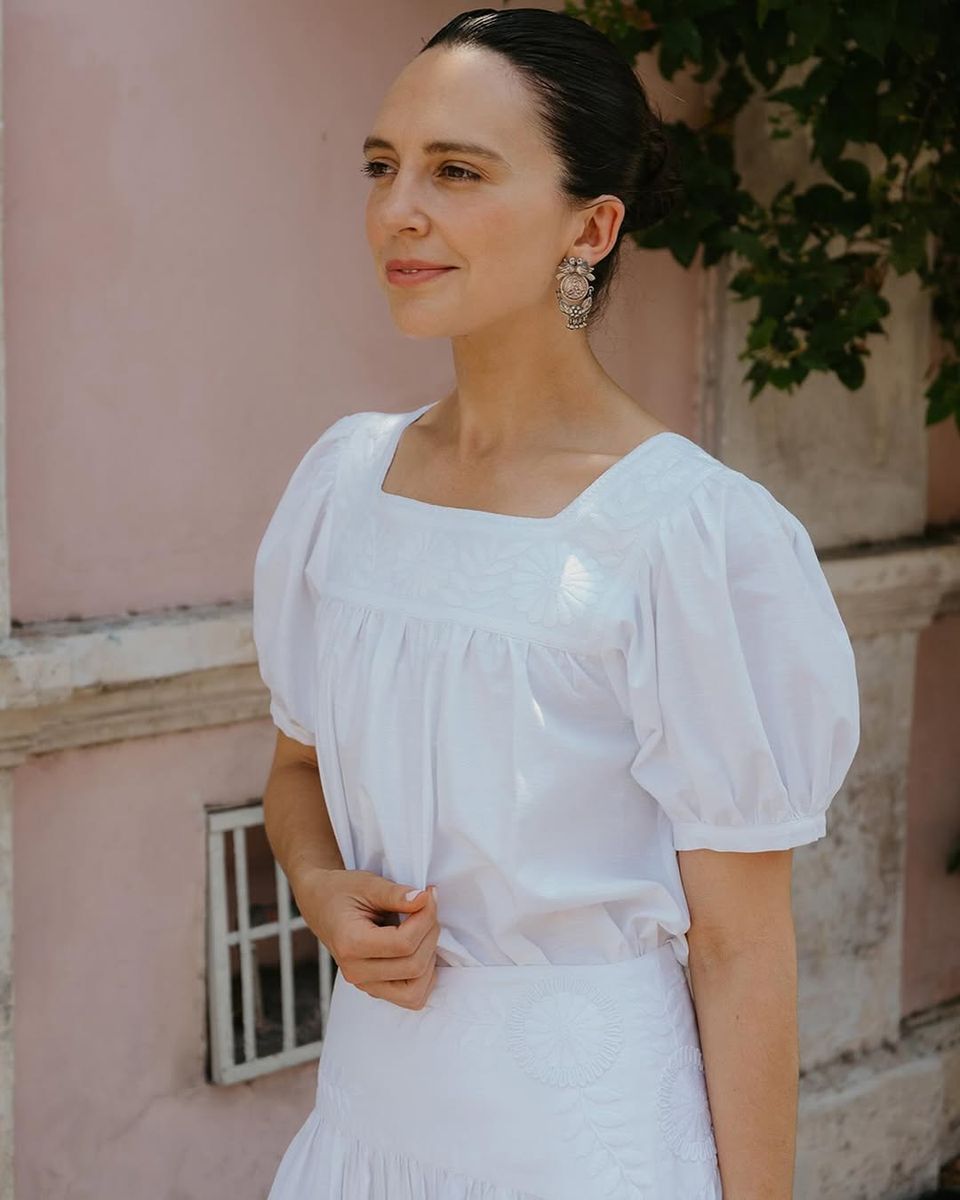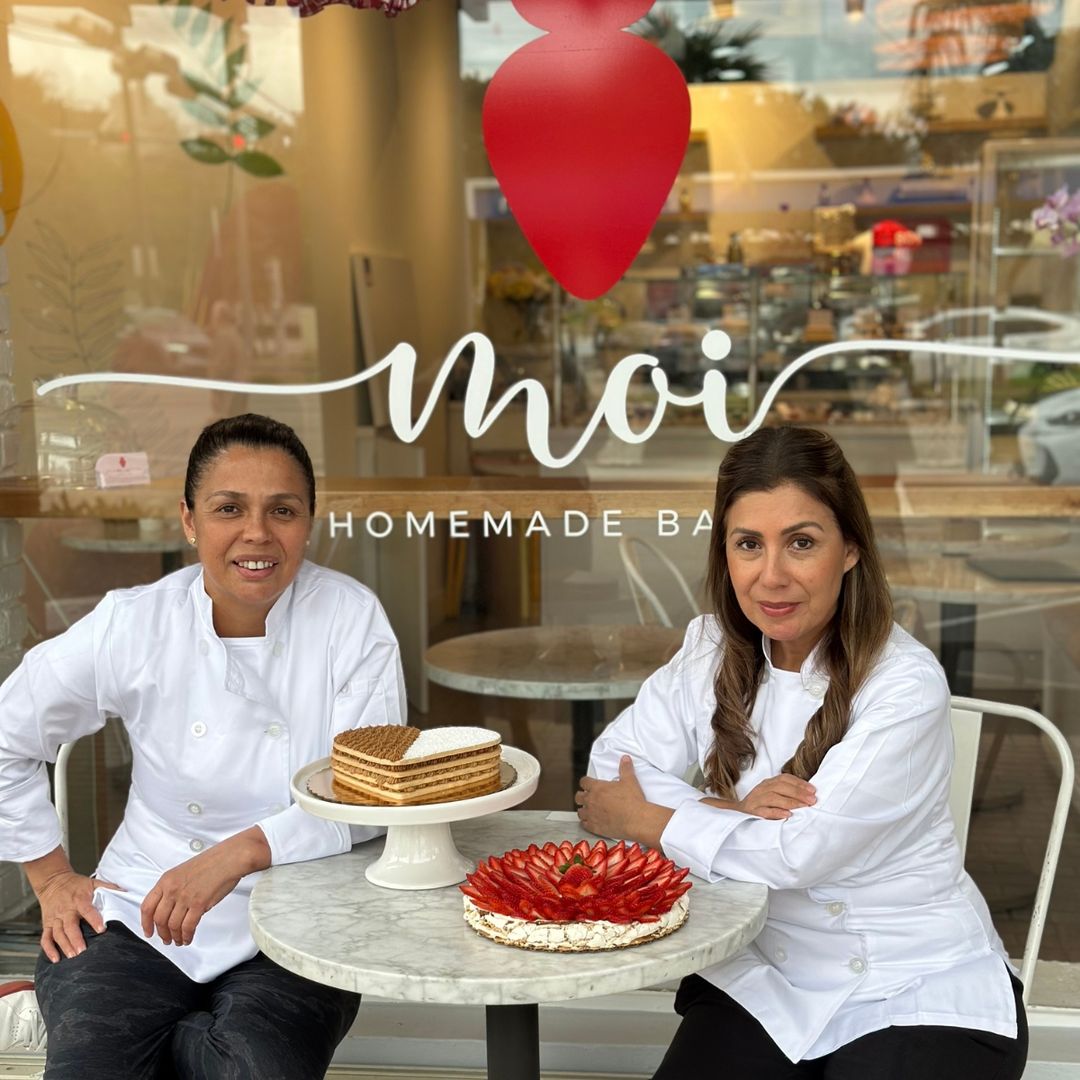When Cristina Lynch speaks about embroidery, she doesn’t describe it as a trend or a technique; instead, she views it as a timeless art form. She speaks of it as a living archive, a language of flowers, vines, and symbols that have been passed down through generations of Mexican artisans.
Raised in Dallas by a Mexican mother whose heart, as she jokes, “is in the shape of Mexico,” Cristina grew up in a home where heritage was everywhere. “I grew up in a house that was covered in things from Mexico, but always beautifully curated,” she recalls. Her mother, born in Coahuila, filled their home with framed textiles, layered Tehuana embroideries from Oaxaca, and ceramics collected since she was a teenager.
“Our home always felt warm and romantic, full of culture. There was always a telenovela playing in the kitchen, we ate Mexican food, and even though we lived in Dallas, it felt like we were living in a little piece of Mexico.”
When asked what moment most shaped her desire to one day create a brand like hers, Cristina reflects that it wasn’t a single defining moment, but rather many. “What really shaped me wasn’t one single moment; it was a series of experiences, and the way I was raised.” Her mother’s passion for collecting extended beyond objects; she also loved stories. She took her to meet artists like Oaxacan painter such as Damián Lescas, whose work was inspired by gastronomy, and Guillermo Olguín.
“Those encounters made me fall in love with the stories behind the work, the meaning in art,” she explains. Family travel deepened that connection: long summer road trips across the U.S. and Mexico brought her to Chiapas and Oaxaca by her early teens. “Those trips mattered so much,” she reflects.
Later, while studying in New York, she was carving her own path. “I double-majored in economics and theater at NYU, nothing to do with fashion, though it taught me a lot.” At the same time, she was immersing herself in the world of luxury through her first job at Oscar de la Renta and a series of fashion internships. “In a way, I was learning it through work,” she says.
Surrounded by the precision and beauty of high fashion, she began to notice what was missing. She remembers being in ABC Home, the iconic New York design marketplace known for its global textiles and curated furnishings and realizing how little from Latin America was represented in design at that time. “Now it’s different, thank goodness. But back then, I thought, Mexico has this richness, these traditions, this incredible luxury in embroidery. Why isn’t it being shown at that level?”
That absence became the seed of Mi Golondrina, the brand founded in 2013, with a simple yet powerful conviction that the artistry of Mexican women deserved to be showcased on the global stage. She was just twenty-three when she launched her first collection, pulling in the traditions she had grown up around. Among the pieces were a few hand-embroidered dresses, which ultimately led her down the path she is on today.
"When I was at Oscar de la Renta, I saw how embroidery was sourced from all over the world, India, everywhere, and it’s gorgeous. But I thought: Mexico has this too. I wanted people to see that Mexican embroidery belongs in that same luxury landscape."
Mi Golondrina is, at its core, an argument in favor of slow fashion, which also has a social dimension and impact. For the artisans the brand employs, consistent income means stability, visibility, and pride. By giving credit and space to their artistry, she is shifting the narrative of what designer fashion can look like, attracting a loyal following of women who want their wardrobes to tell a story deeper than just the latest trend.
¡HOLA! had the opportunity to chat with Cristina about her beginnings and the inspiration to build a business so deeply rooted in her culture. She spoke about working hand in hand with artisans in a sustainable way that keeps this beautiful tradition alive, the impact it has on the women behind every piece, and the love that fuels her team in Dallas. She also shared candid advice for aspiring entrepreneurs, a blend of purpose, passion, and practical wisdom gathered from more than a decade of building her business.
The Artisans and Communities Behind her Brand
Her business embodies slow fashion at its best; it’s intentional, rooted in tradition, built on community, and carries out immense impact by supporting and empowering women. “When people talk about slow fashion, I always laugh because I think we are the slowest version of fashion available,” Cristina says, joking. Mi Golondrina works with hundreds of women across Mexico, organized into groups of thirty, each with one or two leaders. “The leader makes sure everybody has their work, and that it gets done in a timely way. But we never pressure for time. That is something we are very big on.”
Her earliest partnerships began in Oaxaca, where she quickly realized the challenges artisans faced. “A lot of women had inventory they could not sell, or they had buyers who placed orders and disappeared. It was heartbreaking.” Then came Roberta Angeles, her very first partner. “We still work together today. I love her so much. From the beginning, it was about building real relationships. Lunch first, family first, and then work. That is the soul of this business.”
"Every Mi Golondrina garment is born in a small village of Mexico, hand-stitched by skilled artisans who have been using these methods for over 200 years."
From Oaxaca, the network spread into Chiapas, particularly Aguacatenango and Zinacantán. “Word of mouth is how we grew. These are small communities. A woman would tell her cousin or her aunt, ‘I am doing this, do you want to join?’ And that is how it expanded.”
As Cristina Lynch explains, at Mi Golondrina the artisans are not simply contributors, they are the creative heartbeat of every piece. She emphasizes that they are deeply involved in the drawing, choice of colors, and stitches, which makes every garment unique. Cristina underscored, "the artisans are the soul of the brand, and their vision is what transforms every creation into a living work of art."
And it’s very much a teamwork process, with her Dallas team collaborating on fabrics, palettes, and silhouettes.
On Generations and Passing Down Embroidery
The tradition stretches across generations. Cristina recently had a conversation with Elizabeth Cristina Hernández (Eli), an artisan in Zinacantán. “She is my age, with a two-year-old son. She told me she hopes he falls in love with embroidery. Not necessarily as work, but as something he admires and respects. For her, embroidery brings peace, a time to think and be creative.”
Eli also spoke about the bigger picture for her family. Her husband sells flowers, lilies, across Mexico, and she wants her son to appreciate both parents’ work. For Cristina, that moment was profound.
“Even if the children don’t become embroiderers, they carry the respect for tradition. That is what matters. The values are passed on, and families are strengthened.”
From Local Pop-Ups to Today
“In the very beginning, it was really scrappy, and I was nervous”, she laughs. “I used to do pop-ups everywhere. I would fill up my parents’ Suburban with Mexican dresses and just drive to Amarillo, Corpus Christi, you name it. We would sell at these events, and little by little, it grew.”
Those beginnings laid the foundation for what Mi Golondrina has become today: a Dallas flagship store, retail partners, and an online shop that reaches customers worldwide, with its strongest customer base close to home. “Texas is definitely our biggest customer base,” she says. “I think that is just from having started here, doing those pop-ups, and connecting with people face-to-face.”
Bridal orders also played a role in that growth. “We started doing get-ready dresses for brides and bridesmaids. Texas weddings are big, so sometimes we would make thirty dresses for one bridal party. That helped so much in the beginning.”
Even now, she admits, “I still get nervous before we launch something. But we have built a really strong team, both in Dallas and in Mexico, and that makes it possible.”
Symbolism: Flowers, Meanings, and Traditions
At the center of Mi Golondrina are the flowers, traditional symbols and different embroidery techniques. “When we started, we began with San Antonino Castillo Velasco embroidery, which is the pensamientos. I love it. I think it is so beautiful. From there, we began working with communities in Chiapas.”
“If we are working with over 100 women in Aguacatenango, we have to keep their traditionally shaped flowers alive. It is part of who they are, and it is why I fell in love with their work in the first place. The artistry itself is astonishing."
She feels a responsibility to honor what makes each community unique. “In San Antonino, the embroidered flowers can be way more intricate. The flower can be small, but some versions end up in museums with four shades of color inside one flower, and a dress like that can take a year to make. They are truly works of art.”
Cristina grew up hearing about the different techniques. “I always knew the San Antonino dress. Even when I was young, I was familiar with a ‘Deshilado’ - a traditional Mexican garment decorated with delicate embroidery, and it was from Aguascalientes. I even remember it from the lyrics of a song that references it. These traditions were just part of my mom being my mom.”
During our conversation, Cristina sang: “Así se siente, México. Así se siente, México. Como el deshilado de Aguascalientes...”
She continued, "And embroidery itself has a universality. “One of my favorite things is seeing how embroidery has traveled. In Portugal, I saw a blouse and thought, wait, that flower looks just like the Aguacatenango flower. It is amazing how embroidery and culture make their way around the world.”
Balancing Motherhood, Creativity, and Business
Discussing what it is like to be a business owner as a parent and how she balances it, she said, “I really believe in seasons of life. Right now, I’m in a season where I want to be with my kids more. They’re five (almost six), four, and two, and these years are so precious. “In my 20s, I loved working until 9–10 p.m., traveling to Mexico constantly. Now I go less often, though when I do, I sometimes bring the kids.”
She finds creative ways to nurture her relationships with artisans. “I’ve started interviewing and chatting with them more. It’s my way of staying connected to their voices and stories, even when I can’t be on the ground as often.”
“For our 10th anniversary, we gave about 100 women a ‘manta’ (fabric) squares and asked them to embroider what brings them joy. It was the most beautiful project we’ve ever done.Now they’re framed at the store. I loved that because it created another layer of connection through art.”
She shares that motherhood has also shifted her philosophy. “I am currently reading a book called ‘Hunt, Gather, Parent’, which talks about how Mayan communities raise kids. One of the ideas I love is that your children don’t have to be over there while you work over here. You can bring them into the work. So when my daughter comes to the showroom, she takes sewing lessons with our seamstress. It’s adorable, but more than that, it gives her a way to feel part of the company, part of this tradition. I want her to carry that with her.”
Cultivating a Team and Fostering Work-Life Balance
Her Dallas team is the backbone of Mi Golondrina. “We have two women on our marketing team, a merchandise director, who does so much more than that title, and our quality control and fulfillment team in Dallas. They all believe in the mission, and they love what they do.” Work-life balance is essential in our team.
“In New York, I remember coming home at 3 a.m. I did not want that here. If you stay focused, you can get a lot done in a few hours. And kids are welcome at the office. Our merchandise director’s daughter comes and colors, our head of marketing’s son sat in a meeting.”
That sense of joy carries through everything. “Our quality control team even started doing workout classes together. One of them cooks breakfast for everyone, then they start the day. They are hilarious, hardworking, and they have a great time together. That is important to me.”
Advice for Aspiring Entrepreneurs
Cristina also shared her advice for those on the cusp of taking a leap or just starting out. “One thing I would say is start small and do not wait for perfection,” she advises, citing the book 'Just Start' as a key influence. Decide on an investment you are okay losing, then dive in, especially with tools like AI and social media for quick testing.
Customer feedback is crucial. “Listen to your customers. If they prefer one thing over another, pivot. Do not be too stubborn; customers come first.” Cash flow and inventory are make-or-break, as her brother often reminds her. “The biggest part of this business is mastering inventory. Obviously, nobody gets it perfect. That is why there are sales and discounts.”
“One thing I would say is start small and do not wait for perfection. Decide on an investment you are okay losing, then dive in.”
Building banking relationships early pays off. “The bankers were always helpful. They actually want to see you succeed. It is rewarding for them to watch your business grow. When the time comes that you might need credit or a loan, those relationships make all the difference, plus learning how to use business credit and credit cards wisely can be highly beneficial. If you have built trust with your bank from the beginning, you will feel more comfortable asking for help, and they will feel more comfortable helping you.”
Her core message is simple. “Do not be scared. Just go for it. To new entrepreneurs, I would say test it out. Start small. Take it one step at a time. We live in a world where you can start a social media page in five minutes, ask your friends for feedback, and make adjustments quickly. Do not make it bigger in your mind than it is. Just begin.”
